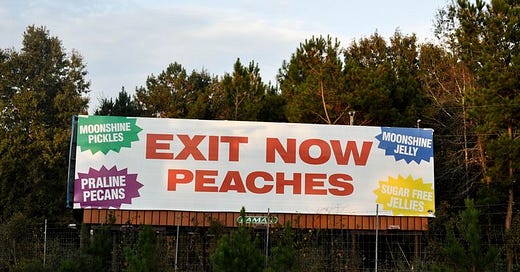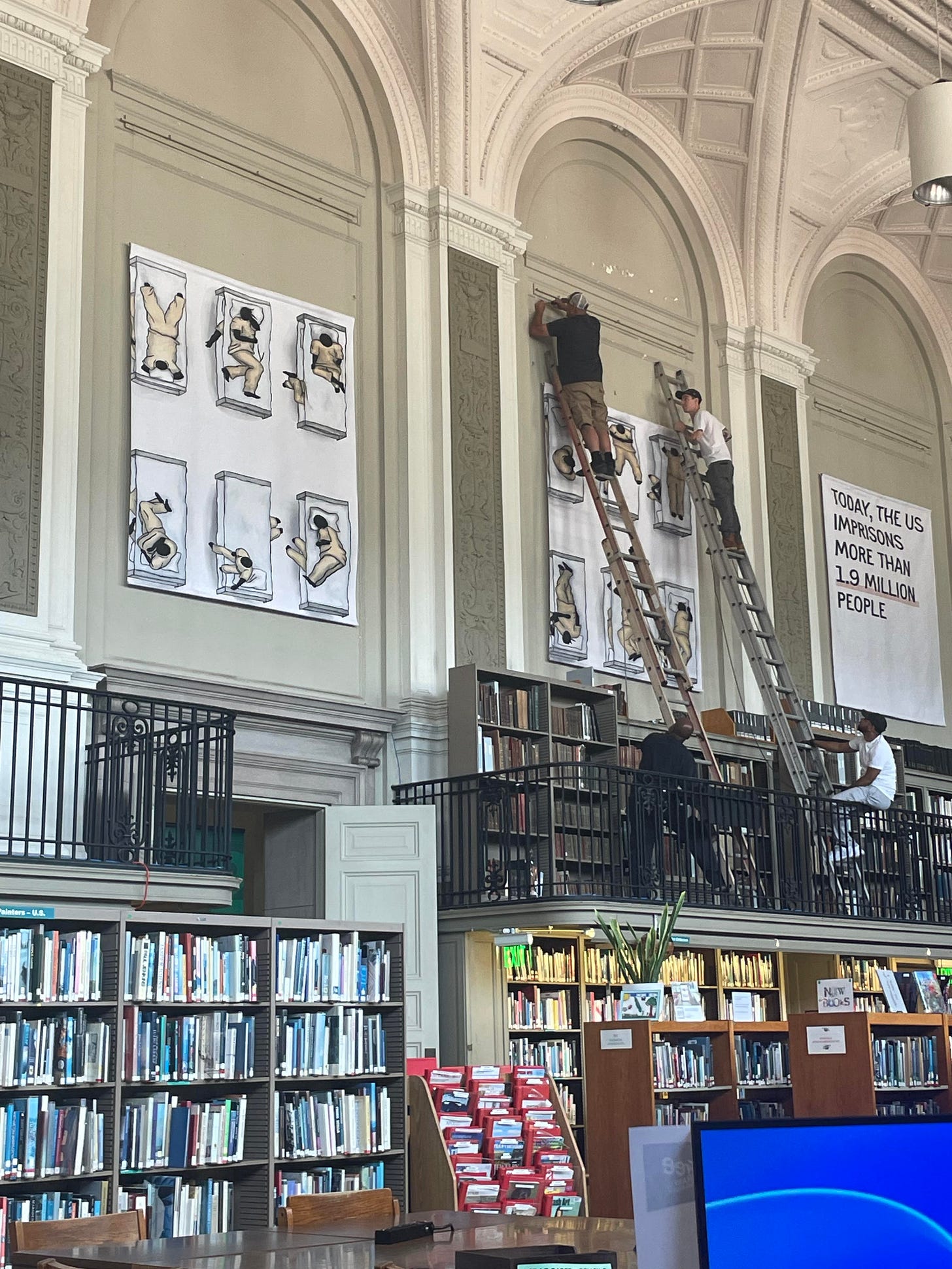CHISELING AWAY THE GENERIC
on making copy more specific (and weird), analyzing book announcements, and The Warehouse Free Library exhibit install.
Last week when we were driving back from the beach my husband pointed out a sign that said, “Peaches 9/10s of a mile” and he said, “that’s so silly, why wouldn’t they just say a mile?”
And my publicity brain went ✨TING TING TING✨ and I said, “so that we have this exact conversation and are more likely to stop.” A mile would go by in our brain’s drive thru, no stick, but 9/10s of a mile is a snag for our pinkish, filmy matter. It’s odd, specific, unordinary.
*
I am someone who firmly believes that every small detail about a book, every crumb of messaging for it and around it, should be so thoughtfully constructed. Small, often seemingly insignificant pieces surrounding a book’s existence (book announcement, book copy, etc, etc), are so important for adding juice (WD40) to a book’s moving parts (& momentum). Part of the reason these things are often rushed is because we live in a hustle culture and it’s easy to just pull copy from a successful book and use it as a kind of mad lib for the next book.
Shout out to poet & senior editor at Four Way Books, Hannah Matheson, who is the best back cover copywriter in the game, and whose words for a book always move me.
*
In the last two weeks, I’ve worked on back cover copy for a poetry collection and a memoir-in-essays, going back and forth in Google docs with authors about what the back of their book will say. When a reader searches online, will they “add to cart.” When they pick up the book randomly in a bookstore, will that person read the first line of the copy and put it back or read on? We have few seconds to snag a reader—how are we going to do it in 150 words (or a first sentence!)
Questions like, “is an adjective like “luminescent” really doing any work at all?” become mighty.
And these conversations, and the copy I’ve read recently on books has told me that we—publishing and writers—have a fear of appearing too outside the mold, too different, too weird. But friends, weirdness, especially in conjunction with the familiar—a whiff of the weird—is what sells a reader.
What you, specifically, are doing in a book that’s not like the rest of the books, is precisely why a reader will pick it up. Yes, there are comp titles, “x meets x in this luminescent debut.” And yes, there are blurbs. We tell readers in so many ways, you’ll love this because you loved this, but where I see us missing is exactly what I love about Zora Neale Hurston’s description of herself in “How It Feels to Be Colored Me,” as a “brown bag of miscellany”—she follows with the objects of herself, “priceless and worthless,” that are overwhelmingly compelling.
*
Here’s an actual comment I made on the copy for a book last week:
“I think a way to standout in a sea of books about motherhood / matrescence (especially right now about invisible care work) is with specificity. What people love about their favorite books isn't some thematic overview or a fancy adjective, it's a very specific scene, line, or moment. You want to try to hook a reader with specifics when they're picking it up when they’re thinking about preordering online. I also worry that the originally copy focuses so much on motherhood that it loses some of the other elements of the book that a reader might hook into--you're asking "age of uncertainty" to do a lot of work.”
When you think of your favorite books, does the adjective “nuanced” move you? Is it that they’re about an agreeable, comparable, time span of your own life?
We’re expecting readers to be as simple as, “oh! I’m middle aged, so of course I care about midlife!)—but in my opinion, readers are smarter than that and care about worlds bigger than themselves. We always lean a little too hard into identity when marketing books, as if the only readers for a book are those that can directly, bodily relate at that exact moment of their life.
Here’s another actual comment for another book entirely:
“I FEEL LIKE WHATEVER WORD WE USE SHOULD BUILD ON BREAKS THROUGH FROM TEMPLATES SECTION? I LIKE TANGLES BUT ITS SORT OF A DIFFERENT METAPHOR. THAT’S WHY LAYS BARE IS PROMISING I THINK, BUT I SEE THE ISSUE WITH “GIRL”! iS ILLUMINATES TOO BORING? (I THINK TOO OFTEN REFERENCED BY BOOKS WITH LITERATURE IN THEM I.E. ILLUMINATED MANUSCRIPTS)”
This comment, I think, really reveals the level of nitpick we should be doing about how our books are announced and marketed, looking so specifically at phrasing.
I wish I could show you our version history for this one.
*
Let’s look at how specificity works and doesn’t in deal announcements for books.
I pulled some random deal announcements, arguably the shortest form we have to announce a book is forthcoming and the first shareable part of a book’s publicity journey. This small, grey screenshot is the first act of (public) publicity for a book. So, while there’s no reason to create sticking power with it since there usually isn’t a pre-order link at that time, it is the first “defining” messaging about a book. Thus, it’s important to writers more than readers, but those “saves” on Twitter, mean something. If you snag a reader at this stage, when they see the book again, they’ll add to cart.
#1: I am the target audience for this book and yet this is so general and bland (plus the use of “just” in the title which could be satire—phrasing we often use towards new moms, “it’s just a season, one day you’ll miss…” but the copy doesn’t point toward the title’s satire, so it could be the author’s intentional phrasing). There are so many books about these things hitting the market. My anxiety is already overwhelming, and “midlife” feels like the new "new adult.” It’s a 2024 book buzz word for sure. It’s just … it’s boring. Perhaps it didn’t need to be more than boring because Taylor Wolfe’s blog (and her name) will move her audience, but I would argue they’re not bringing anyone new in here? I didn’t know Taylor Wolfe before reading this and this didn’t make me excited to pick up her previous book or this one.
#2: The list is so long here. And lists are a part of copy that I think can really work because you can do a sort of “one of these things is not like the other.” I love a list of three things where two are alike and one makes a reader go … “wait, what?” But to list seven things in a list (several which fill the same category—fables, fairy tales and mythology?). You know what I want to know, tell me more about the “games.”
And there we go with the “care” question which is so hot in books right now (as it should be, we should be navigating this question), but how is this different than the other books? What are you saying that’s new? Why now and so what?
#3: You know what makes me want to read this? The phrase “hackneyed portrayals of trauma…” perhaps, truly, just the word “hackneyed.” I like the list here a bit more, but it’s still kind of repetitive in idea (sensuality, longing, eroticism, and ecstasy—they’re all doing very similar work, or could be synonyms of one another. When included together they act as a sort of wash, but if you pulled a few and gave a bit more context, it might pull a reader in more).
#4: This one has me convinced we think of mothers (and all tangential phrasing around their identity) as a monolith. I like “organized around the hours of a day” as a craft (structural) element of the book that would intrigue me, but otherwise, this has all been said about so many books before.
#5: Here’s a list that’s gripping because of the middle, “and the spirit catching up with the body…” we have a few more regular topics for essays and then BAM. The fact that it is slightly left-of-center to the rest of the lists functioning makes me go, “ouuuuuu, wait a second…”
#6: This one made me L O L. And I love that it’s Duke University Press because let’s be real, small, independent, and university presses (maybe) have more time to write good copy, and they know it matters in the long run more than a big four book that’s going to just shove money into marketing visibility. I love the “re-parking” line because one of the ways my husband and I differ is parking (and driving in general). Tell me why this man always wants to park as far away as he possibly can from the building? Tell me why he never finds a tree to park under. I can just see Beller’s wife in this copy.
It’s really just the ONE THING. There’s so much usual here. “delves deeply into decades past” — points for alliteration, but bleh on what the book is doing. The ONE THING here is re-parking (and the list of foot, skateboard, on bicycle, which says, “I’m not a regular dad, I’m a cool dad.”
#7: I know this book is going to be good, and yet this copy is every essay collection in the last few years. I am so ready for new ways of saying “blends memoir and cultural criticism…” WE GET IT. Zoe says that line actually just makes the case for an essay, which is so true.
*
What I mean to say about all of this is if the idea or concept isn’t selling the book (like this copy below, holy shit can’t wait to read), and the craft and ideas are the things that will sell a reader, (I love the phrase “it’s in the read” especially for essay collections), then we have to do a better job of chiseling away the generic and getting under the skin of the thing.
One of the coolest publicity things in a while happened this week. Vic Liu’s illustrations from her book co-authored with National Book Award winner James Kilgore, The Warehouse: A Visual Primer on Mass Incarceration, were installed at Philadelphia’s Free Library through October. (They have an event there July 23, you should go!). But how cool is this exhibit?
You can read more about the book, the install, and the authors, at the Philadelphia Inquirer.
As always, the Pine State calendar of events lives here, and you can buy our books here! You can also see what we’re working on and contact us through our website, Pinestatepublicity.com.
ICYMI: Jessica Jacobs got a STARRED REVIEW in Library Journal for unalone and was the review of the day & it was also beautifully reviewed in Tupelo Quarterly, Rachel Zimmerman was the Saturday essay at Wall Street Journal, Mettlework by Jessica E. Johnson was reviewed in Pop Matters, Jenny Irish’s Hatch was reviewed in Heavy Feather Review, Jason K. Friedman’s Liberty Street was reviewed in Southern Literary Review and Jewish Review of Books, Cynthia Hoffman’s Exploding Head was reviewed in On The Seawall, The Warehouse was excerpted in the July issue of The Nation, and so much more on our Twitter & Instagram.




















Here is my absolute favorite example: Cat rescuer and creator of the TikTok account @PoetsSquareCats Courtney Gustafson's POETS SQUARE: ESSAYS ON CATS & COMMUNITY, a memoir-in-essays, which tells the brutal and tender stories of cats the author has saved (or failed to save) as a lens to explore everything from poverty and mental health to morality and misogyny, pitched as H IS FOR HAWK with an internet habit, or WINTERING with a few dozen feral cats, to Libby Burton at Crown, in a pre-empt, by Caroline Eisenmann at Frances Goldin Literary Agency (NA).
For some reason I spent this morning reading the Publisher's Weekly deal announcements (which I never do!), and I kept thinking how poorly written most of them were! So it was a delight to read your post just now and have you do this excellent and very satisfying close reading! :)